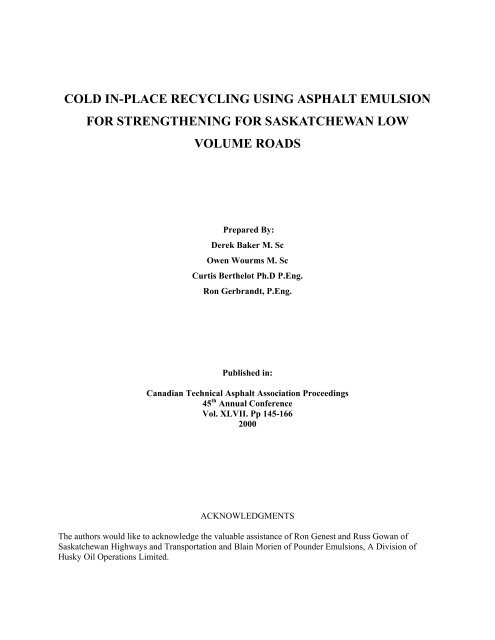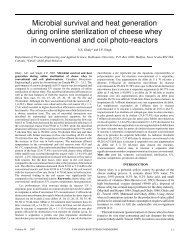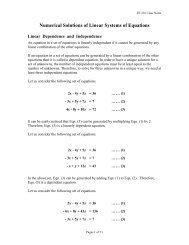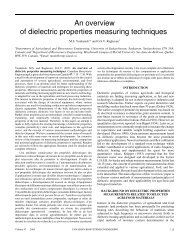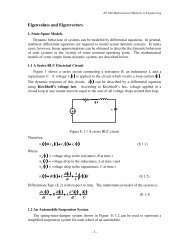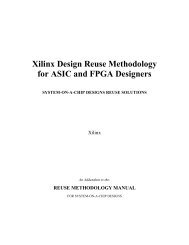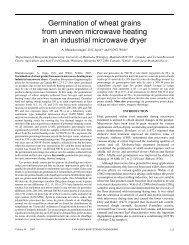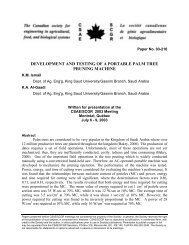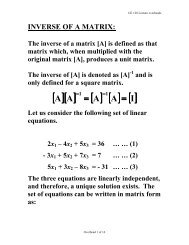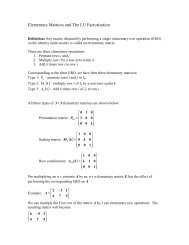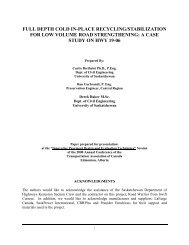Cold-In-Place Recycling using Asphalt Emulsion for Stabilization of ...
Cold-In-Place Recycling using Asphalt Emulsion for Stabilization of ...
Cold-In-Place Recycling using Asphalt Emulsion for Stabilization of ...
Create successful ePaper yourself
Turn your PDF publications into a flip-book with our unique Google optimized e-Paper software.
COLD IN-PLACE RECYCLING USING ASPHALT EMULSION<br />
FOR STRENGTHENING FOR SASKATCHEWAN LOW<br />
VOLUME ROADS<br />
Prepared By:<br />
Derek Baker M. Sc<br />
Owen Wourms M. Sc<br />
Curtis Berthelot Ph.D P.Eng.<br />
Ron Gerbrandt, P.Eng.<br />
Published in:<br />
Canadian Technical <strong>Asphalt</strong> Association Proceedings<br />
45 th Annual Conference<br />
Vol. XLVII. Pp 145-166<br />
2000<br />
ACKNOWLEDGMENTS<br />
The authors would like to acknowledge the valuable assistance <strong>of</strong> Ron Genest and Russ Gowan <strong>of</strong><br />
Saskatchewan Highways and Transportation and Blain Morien <strong>of</strong> Pounder <strong>Emulsion</strong>s, A Division <strong>of</strong><br />
Husky Oil Operations Limited.
148 USING ASPHALT EMULSION TO STABILIZE LOW VOLUME ROADS<br />
ABSTRACT<br />
Grain transportation rationalization and value added initiatives within the agriculture and resource<br />
sectors are significantly increasing truck traffic on Saskatchewan roads. As a result, there is a need to<br />
strengthen many low volume roads. However, budget constraints and aggregate shortages in some areas<br />
<strong>of</strong> the province render conventional road strengthening techniques untenable. Because <strong>of</strong> this,<br />
Saskatchewan Department <strong>of</strong> Highways and Transportation is investigating cold in-place recycling and<br />
alternative strengthening techniques <strong>for</strong> low volume roads. Several test sections were constructed during<br />
the summer <strong>of</strong> 1999 to evaluate cold in-place recycled and asphalt emulsion strengthened road systems.<br />
This study included a sensitivity analysis <strong>of</strong> two cold in-place recycled mixes from Highway 15 (recycled<br />
asphalt mat on subgrade and a recycled granular patch) and a virgin laboratory blend control mix<br />
(standard SDHT Type 71 hot mix aggregate blend), mixed with two asphalt emulsions (HF-150S and SS-<br />
1C). Compacted specimens were tested <strong>for</strong> standard Proctor moisture-density and Marshall stability. The<br />
laboratory observations were compared with those in the Highway 15 field test sections. This study<br />
identified specific issues required <strong>for</strong> the engineering, construction and quality control-quality assurance<br />
<strong>of</strong> cold in-place recycled and asphalt emulsion stabilized road systems.<br />
RÉSUMÉ<br />
La rationalisation du transport du grain et les initiatives de la valeur ajoutée dans les secteurs de<br />
l'agriculture et des ressources augmentent considérablement la circulation des camions sur les routes de la<br />
Saskatchewan. Il en résulte donc un besoin de ren<strong>for</strong>cer plusieurs routes à faible trafic. Cependant, les<br />
contraintes budgétaires et la pénurie de granulats dans certaines régions de la province rendent<br />
indéfendables les techniques conventionnelles de ren<strong>for</strong>cement des chaussées. À cause de cela, le<br />
Ministère de la Voirie et des Transports de la Saskatchewan examine le recyclage à froid en place et les<br />
techniques alternatives de ren<strong>for</strong>cement pour les routes à faible trafic. Plusieurs sections d'essais ont été<br />
construites durant l'été 1999 pour évaluer les réseaux routiers recyclés à froid en place et ren<strong>for</strong>cés à<br />
l'émulsion de bitume. Cette étude inclut une analyse de sensibilité de deux enrobés recyclés à froid en<br />
place: un de l'autoroute 15 (couche de revêtement bitumineux recyclé sur une infrastructure et un<br />
rapiéçage granulaire recyclé) et un d'un mélange contrôle vierge en laboratoire (enrobé à chaud standard<br />
SDHT Type71), malaxés avec deux émulsions de bitume (HF-150S et SS-1C). Sur des échantillons<br />
compactés, on a fait les essais Proctor standard de densité - humidité et l'essai de stabilité Marshall. Les<br />
données de laboratoire ont été comparées à celles des sections d'essais de l'autoroute 15. Cette étude a<br />
identifié des résultats spécifiques requis par l'ingénierie, la construction, le contrôle et l'assurance de la<br />
qualité des réseaux routiers recyclés à froid en place et stabilisés à l'émulsion de bitume.
BAKER, WOURMS, BERTHELOT & GERBRANDT 149<br />
1 INTRODUCTION<br />
Saskatchewan Department <strong>of</strong> Highways and Transportation (SDHT) is responsible <strong>for</strong><br />
maintaining approximately 10,000 km <strong>of</strong> low volume roads, which accounts <strong>for</strong> more than a one-third <strong>of</strong><br />
the Provincial Highway system [1]. Many <strong>of</strong> these low volume roads, such as thin membrane surfaced<br />
(TMS) and asphalt mat on subgrade (AMOS) are rapidly deteriorating because <strong>of</strong> increasing truck traffic<br />
resulting from rationalization <strong>of</strong> the transportation system. As a result, much <strong>of</strong> the Saskatchewan low<br />
volume road system needs to be strengthened. However, budget constraints render conventional<br />
strengthening solutions untenable in many applications. <strong>Cold</strong> in-place recycling and asphalt emulsion<br />
strengthening may present an economical interim solution <strong>for</strong> some failing low volume roads.<br />
1.1 Background<br />
From 1950 to 1970, SDHT constructed approximately 8600 km <strong>of</strong> TMS and AMOS roads<br />
throughout the province. TMS and AMOS roads did not significantly improve structural strength, but<br />
provided a cost effective dust, mud, and stone-free rural road system. Figure 1 compares the cross<br />
sections <strong>of</strong> a typical TMS/AMOS road structure and a standard structural pavement [2].<br />
TMS/AMOS<br />
STRUCTURAL PAVEMENT<br />
20 TO 40mm COLD MIX<br />
OR 150mm HMAC MAT<br />
GRAVEL<br />
SHOULDER<br />
SUBGRADE<br />
80 TO 130mm ASPHALT<br />
CONCRETE<br />
SHOULDER VARIES FROM 45mm<br />
ASPHALT CONCRETE TO<br />
GRAVEL<br />
150 TO 200mm<br />
BASE<br />
Figure 1 TMS/AMOS and Standard Structural Pavement Cross-Sections<br />
(TMS = thin membrane surfaced; AMOS = asphalt mat on subgrade; HMAC = hot mix asphalt concrete)<br />
Rationalization <strong>of</strong> transportation in Canada has encouraged the use <strong>of</strong> larger, more efficient<br />
trucks, including eight and nine-axle commercial trucks, on rural roads. The increase in the weights,
150 USING ASPHALT EMULSION TO STABILIZE LOW VOLUME ROADS<br />
dimensions and volumes <strong>of</strong> the truck traffic on Saskatchewan roads poses a serious problem with regards<br />
to the per<strong>for</strong>mance <strong>of</strong> Saskatchewan TMS and AMOS roads [1]. Currently, SDHT employs a number <strong>of</strong><br />
preservation treatments <strong>for</strong> TMS and AMOS roads [2].<br />
• Graded aggregate seal: surface treatment <strong>for</strong> minor fatigue cracking or rutting.<br />
• <strong>Cold</strong> mix patching: repair <strong>of</strong> surface breaks in localized areas with intensive cracking.<br />
• Base overlay with a double-seal wearing course: complete rehabilitation <strong>of</strong> failed low<br />
volume roads.<br />
• Reversion to gravel: interim treatment to improve the safety <strong>of</strong> failing low volume roads<br />
under budget constraints.<br />
Because current budgets are unable to maintain an acceptable level <strong>of</strong> service across the entire road<br />
network <strong>using</strong> conventional preservation treatments, innovative strengthening treatments are being<br />
investigated. Recent advancements in cold in-place recycling (CIR) make CIR an attractive treatment<br />
alternative <strong>for</strong> strengthening Saskatchewan low volume roads [3, 4, 5]. An advantage to CIR technology<br />
is that it provides the ability to blend stabilizers into the reclaimed material via computer-controlled<br />
injection directly in to the milling drum.<br />
Figure 2 <strong>Stabilization</strong> With <strong>Cold</strong> <strong>In</strong>-<strong>Place</strong> <strong>Recycling</strong><br />
<strong>In</strong> 1999, SDHT undertook a number <strong>of</strong> CIR projects involving asphalt emulsion stabilization.<br />
The objective <strong>of</strong> this study was to evaluate cold in-place recycled mixes stabilized with alternative asphalt<br />
emulsions. The scope <strong>of</strong> this study included:<br />
‣ Reclaimed material obtained from the rehabilitation <strong>of</strong> Highway 15-10:
BAKER, WOURMS, BERTHELOT & GERBRANDT 151<br />
• Recycled asphalt pavement comprising 50 mm <strong>of</strong> virgin aggregate milled into the existing<br />
asphalt mat on a clay-till subgrade.<br />
• Recycled asphalt pavement comprising 50 mm <strong>of</strong> virgin aggregate milled into a double sealwearing<br />
course over a granular patch.<br />
‣ Standard SDHT Type 71 aggregate obtained from Highway 1-20 construction site.<br />
‣ <strong>Asphalt</strong> emulsion stabilizers HF-150s and SS-1c.<br />
‣ Marshall specimens prepared based on <strong>Asphalt</strong> <strong>In</strong>stitute MS-19, AASHTO Task Force 38 and<br />
Oregon DOT standard methods [6, 7, 8, 9].<br />
‣ <strong>Asphalt</strong> emulsion contents based on surface and base course mix design as per <strong>Asphalt</strong> <strong>In</strong>stitute<br />
MS-19.<br />
‣ Mix evaluation including Proctor moisture-density and Marshall stability <strong>of</strong> the alternative cold<br />
in-place recycling mixes.<br />
2 HIGHWAY 15 PRELIMINARY SITE INVESTIGATION<br />
Figures 3 and 4 show common distresses found throughout the Highway 15-10 test site prior to<br />
reclamation. Common distresses found on Highway 15-10 included low to moderate fatigue cracking,<br />
moderate shoving, potholes, severe rutting, transverse cracking, and numerous surface breaks on the outer<br />
and inner wheel path. The as-built records <strong>of</strong> Highway 15-10 show 150 mm <strong>of</strong> hot mix asphalt<br />
constructed over a prepared subgrade. However, years <strong>of</strong> traffic and preservation treatments have<br />
resulted in variability <strong>of</strong> the asphalt concrete mat. Figure 5 illustrates the ground penetrating radar (GPR)<br />
thickness-pr<strong>of</strong>ile <strong>for</strong> one <strong>of</strong> the Highway 15-10 test sections. As seen in Figure 5, the surface layer was<br />
found to range from 25 mm to 225 mm with several granular deep patches.<br />
Figure 3 Typical Surface Distresses on Highway 15-10
152 USING ASPHALT EMULSION TO STABILIZE LOW VOLUME ROADS<br />
Figure 4 Typical Surface Distresses on Highway 15-10<br />
Figure 5 Ground Penetrating Radar Thickness Plot <strong>of</strong> Highway 15-10
BAKER, WOURMS, BERTHELOT & GERBRANDT 153<br />
3 HIGHWAY 15-10 CONSTRUCTION RESULTS<br />
Figure 6 illustrates an area <strong>of</strong> the test section that contained a granular patch prior to rotomixing.<br />
The steel drum rollers caused a checking failure in the surrounding area, except <strong>for</strong> the area that contained<br />
the granular patch. Not only did this section compact better, it withstood the short-term impact <strong>of</strong> the<br />
traffic unlike the rest <strong>of</strong> the test sections, which can be seen in Figure 7. Soon after Highway No. 15-10<br />
was open to traffic, numerous s<strong>of</strong>t spots began to develop at various locations throughout the test sites.<br />
Figure 6 Highway 15-10 Granular Patch after Construction
154 USING ASPHALT EMULSION TO STABILIZE LOW VOLUME ROADS<br />
Figure 7 Tender Spots in Highway 15-10 after Construction<br />
4 LABORATORY CHARACTERIZATION OF ROTOMIXED AGGREGATE MATERIALS<br />
Ground Penetrating Radar was used to identify specific areas from which samples were retrieved<br />
from Highway 15-10, including areas where 50 mm <strong>of</strong> granular base had been rotomixed into the asphalt<br />
mat, and where 50 mm <strong>of</strong> granular base had been rotomixed into a granular patch. <strong>In</strong> addition to the<br />
recycled material, a laboratory control blend was prepared <strong>using</strong> a standard SDHT Type 71 Marshall<br />
dense graded hot mix aggregate gradation. (is there some simple way <strong>of</strong> characterizing “SDHT Type 71”<br />
aggregate, <strong>for</strong> the benefit <strong>of</strong> those readers not familiar with “SHDT Type 71”).<br />
Figure 8 illustrates the grain size analysis results obtained from the four aggregate types<br />
considered in this study. The SDHT Type 71 hot mix aggregate blend was prepared in the laboratory<br />
<strong>using</strong> the gradation specified <strong>for</strong> Highway 1-20 paving project and the rotomixed aggregate from<br />
Highway 15-10 was taken directly from the roadbed after the first pass with the cold in-place recycler.
BAKER, WOURMS, BERTHELOT & GERBRANDT 155<br />
100<br />
90<br />
80<br />
70<br />
Percent Passing<br />
60<br />
50<br />
40<br />
30<br />
20<br />
10<br />
0<br />
0.071 0.4 0.9 2.0 5.0 9.0 12.5 16.0 18.0<br />
0.16<br />
Sieve Size 0.45 (mm)<br />
CIR AMOS<br />
CIR Granular Patch<br />
SDHT Type 71 <strong>Asphalt</strong> Concrete Mix<br />
Granular Base Stockpile<br />
25<br />
Figure 8 Gradation <strong>of</strong> Aggregate Materials from Saskatchewan Highway 15-10<br />
(CIR = cold in-place recycled; AMOS = asphalt mat on subgrade; SDHT = Saskatchewan Department <strong>of</strong><br />
Highways and Transportation<br />
At first glance, the grain size distribution <strong>of</strong> the rotomixed material retrieved from the Highway<br />
15-10 roadbed showed little difference between the rotomixed AMOS and granular patch. However,<br />
further investigation determined that the CIR mixtures contained significant clay lumps as shown in<br />
Figure 9. To quantify the portion <strong>of</strong> clay lumps contained within the Highway 15-10 rotomixed material,<br />
the recycled materials were soaked in water <strong>for</strong> 24 hours and periodically agitated by hand to disintegrate<br />
the clay lumps. The soaked recycled materials were then subjected to a washed grain size analysis, as<br />
illustrated in Figure 10.<br />
The proportion <strong>of</strong> residual asphalt cement in the recycled mix was determined by placing the CIR<br />
material in an ignition oven to burn <strong>of</strong>f all the asphalt cement particles. The resulting extracted gradation,<br />
which excludes the clay lumps and asphalt cement in the CIR material is also shown in Figure 10.
156 USING ASPHALT EMULSION TO STABILIZE LOW VOLUME ROADS<br />
Figure 9 Clay Lumps Contained Within Recycled Highway 15-10 Test Sections<br />
Sand equivalency testing was also per<strong>for</strong>med to quantify the amount <strong>of</strong> fines in the material. The<br />
sand equivalency value is computed as the ratio <strong>of</strong> the sand to clay fractions as determined by settlement<br />
in a standing hydrometer and is expressed as a percentage. As seen in Figure 11, the CIR granular patch<br />
and SDHT Type 71 had sand equivalency values <strong>of</strong> 61 and 51, respectively. Both <strong>of</strong> these materials meet<br />
the specifications <strong>for</strong> a SuperPave Level 1 hot mix. However, the CIR AMOS material did not meet<br />
the minimum SuperPave TM criterion <strong>for</strong> sand equivalency <strong>of</strong> 36.<br />
Figure 10 shows the fine and sand sized particles <strong>of</strong> each material gradation. It can be seen that<br />
the percent fines (defined as percent passing the No. 200 or 0.071 mm sieve) in the Highway 15-10<br />
rotomixed material increases substantially once the clay lumps are broken down. The granular patch<br />
contained approximately ten percent passing the No. 200 sieve while the rest <strong>of</strong> the AMOS showed<br />
approximately 17 percent passing the No. 200 sieve. This indicates that the subgrade was probably milled<br />
into the reclaimed material during reclamation <strong>of</strong> the AMOS.
BAKER, WOURMS, BERTHELOT & GERBRANDT 157<br />
Percent Passing by Weight<br />
50<br />
45<br />
40<br />
35<br />
30<br />
25<br />
20<br />
15<br />
10<br />
5<br />
0<br />
0.071 0.16 0.4 0.9 2.0<br />
Sieve Size (mm)<br />
CIR AMOS Original<br />
CIR AMOS Soaked and Washed<br />
CIR AMOS Extracted<br />
CIR Granular Patch Original<br />
CIR Granular Patch Soaked and Washed<br />
CIR Granular Patch Extracted<br />
Figure 10 Grain Size Distribution <strong>of</strong> Highway 15-10 <strong>Cold</strong> in-<strong>Place</strong> Recycled (CIR) Materials<br />
(AMOS = asphalt mat on subgrade)<br />
70<br />
60<br />
Sand Equivalent (%)<br />
50<br />
40<br />
30<br />
20<br />
SUPERPAVE<br />
10<br />
0<br />
CIR AMOS CIR Granular Patch SDHT 71 Aggregate<br />
Figure 11 Sand Equivalency <strong>of</strong> Highway 15-10 <strong>Cold</strong> in-<strong>Place</strong> Recycled Materials (CIR) and Saskatchewan<br />
Department <strong>of</strong> Highways and Transportation (SDHT) Type 71 Hot Mix Aggregate<br />
(AMOS = asphalt mat on subgrade)
158 USING ASPHALT EMULSION TO STABILIZE LOW VOLUME ROADS<br />
5 LABORATORY ANALYSIS OF ASPHALT EMULSION<br />
The characteristics <strong>of</strong> each asphalt emulsion used in this study are summarized in Table 1.<br />
Table 1 <strong>Asphalt</strong> <strong>Emulsion</strong> Characteristics<br />
CHARACTERISTICS HF-150S* SS-1C**<br />
Viscosity @ 50 deg C, S.F.S. (ASTM D 244) 65 -------<br />
Viscosity @ 25 deg C, S.F.S. (ASTM D 244) ------- 23<br />
Penetration <strong>of</strong> residue@ 25 deg C<br />
(100gm, 5 sec), dmm (ASTM D 5) 182 200<br />
Residue by distillation, % by weight (ASTM D 244) 61.1 59.4<br />
Total distillate, % by weight (ASTM D 244) 38.7 40.5<br />
Oil portion <strong>of</strong> distillate, % by weight. (ASTM D 244) 1.7 0.5<br />
* HF-150s is a high float medium setting asphalt emulsion designed <strong>for</strong> seal coating<br />
**SS-1c is a slow setting cationic asphalt emulsion.<br />
As can be seen in Table 1, the properties <strong>of</strong> HF-150s and SS-1c are similar. The primary<br />
difference between HF-150s and SS-1c is that HF-150s is a medium set emulsion where as SS-1c is a<br />
slow setting emulsion. The <strong>Asphalt</strong> <strong>In</strong>stitute’s Manual Series -19 (MS-19) [7] states that a medium set<br />
emulsion is normally used with aggregates that do not have an excessive amount <strong>of</strong> fines. Conversely,<br />
slow setting emulsions are normally used with aggregates that have a significant amount <strong>of</strong> fines [7]. HF-<br />
150s emulsifier also imparts a gel structure to the asphalt residue. This gel structure and chemical charge<br />
results in increased film thickness, which prevents the asphalt cement from bleeding and draining down<br />
<strong>of</strong>f the aggregates. SS-1 is slow setting because <strong>of</strong> the higher amount <strong>of</strong> emulsifier present in the<br />
emulsion, which prevents it from breaking as soon as it becomes in contact with the aggregate.<br />
6 LABORATORY MIX ANALYSIS<br />
The <strong>Asphalt</strong> <strong>In</strong>stitute MS-19 [7] mix analysis procedure was used to determine the target design<br />
asphalt emulsion contents <strong>for</strong> each mix. MS-19 contained two <strong>for</strong>mulas based on the percentage <strong>of</strong><br />
aggregate passing the 4.75 mm (No. 4) sieve. (Is there a reason why part <strong>of</strong> Equation 1 is italicized)<br />
Base Mix Percent <strong>Emulsion</strong><br />
=<br />
Surface Mix Percent <strong>Emulsion</strong> =<br />
[( 0.06×<br />
B) + ( 0.01×<br />
C)<br />
] × 100<br />
A<br />
[( 0.07 × B) + ( 0.03 × C)<br />
]<br />
A<br />
× 100<br />
(1)<br />
(2)<br />
Where:<br />
Percent <strong>Emulsion</strong> = estimated initial percent asphalt emulsion by dry weight <strong>of</strong> aggregate<br />
A = percent residue <strong>of</strong> emulsion by distillation<br />
B = Percent <strong>of</strong> dry aggregate passing 4.75mm (No. 4) sieve<br />
C = Percent <strong>of</strong> dry aggregate retained on 4.75mm (No. 4) sieve
BAKER, WOURMS, BERTHELOT & GERBRANDT 159<br />
Table 2 summarizes the emulsion contents required <strong>for</strong> the CIR AMOS, CIR Granular Patch and<br />
SDHT Type 71 as specified by MS-19 <strong>for</strong> surface and base mix.<br />
Table 2 Target Design Percent <strong>Asphalt</strong> <strong>Emulsion</strong> Content <strong>for</strong> Various Aggregate Types<br />
AGGREGATE TYPE MIXTURE TYPE<br />
TARGET DESIGN<br />
ASPHALT EMULSION,<br />
%<br />
CIR AMOS Base 6.0<br />
Surface 8.0<br />
CIR Granular Patch Base 7.0<br />
Surface 9.0<br />
SDHT Type 71 Base 5.5<br />
Surface 8.0<br />
CIR = cold in place recycled; AMOS = asphalt mat on subgrade;<br />
SDHT = Saskatchewan Department <strong>of</strong> Highways and Transportation<br />
6.1 Standard Proctor Moisture Density Evaluation<br />
Previous works recommend compacting asphalt emulsion mixes at total liquids content equal to<br />
optimal standard Proctor moisture content [7, 8, 9]. Standard Proctor moisture-density properties <strong>of</strong> each<br />
aggregate type at each design asphalt emulsion content were there<strong>for</strong>e determined <strong>for</strong> the three mix<br />
aggregates and two asphalt emulsion types. As seen in Figures 11 through 16, the optimum total liquids<br />
content with asphalt emulsion added was always higher than without asphalt emulsion whereas the<br />
maximum dry density with asphalt emulsion was always lower than without asphalt emulsions added to<br />
the mix. It is also interesting to note that materials compacted with SS-1c had a higher dry density than<br />
when compacted with HF-150s.<br />
It was found during lab characterization that the total liquids content significantly affects mixing<br />
and coating <strong>of</strong> aggregate particles. It was found that SS-1c coated the aggregate particles reasonably well<br />
at standard optimum moisture content, whereas HF-150s was observed to have poor coating at all<br />
moisture contents. Similarly, the SDHT Type 71 standard Marshall dense graded hot mix aggregate blend<br />
showed that the HF-150s broke once the emulsion came into contact with the sands and fines, making it<br />
difficult to achieve reasonable coating at any water content. Conversely, SS-1c asphalt emulsion coated<br />
the SDHT Type 71 virgin aggregate blend well at optimal moisture content.
160 USING ASPHALT EMULSION TO STABILIZE LOW VOLUME ROADS<br />
2000<br />
1950<br />
Dry Density (kg/m 3 )<br />
1900<br />
1850<br />
1800<br />
1750<br />
1700<br />
1650<br />
1600<br />
7.0 8.0 9.0 10.0 11.0 12.0 13.0 14.0 15.0 16.0<br />
Total Liquids Content (%)<br />
Unmodified 6% SS-1c 8% SS-1c<br />
Figure 11 Standard Proctor Moisture Density Relationship <strong>of</strong> <strong>Cold</strong> <strong>In</strong>-place Recycled <strong>Asphalt</strong> Mat<br />
On Subgrade With and Without the Slow Setting Cationic <strong>Asphalt</strong> <strong>Emulsion</strong> SS-1c<br />
Dry Density (kg/m 3 )<br />
2000<br />
1950<br />
1900<br />
1850<br />
1800<br />
1750<br />
1700<br />
1650<br />
1600<br />
7.0 8.0 9.0 10.0 11.0 12.0 13.0 14.0 15.0 16.0<br />
Total Liquids Content (%)<br />
Unmodified 6% HF-150s 8% HF-150s<br />
Figure 12 Standard Proctor Moisture Density <strong>of</strong> <strong>Cold</strong> <strong>In</strong>-<strong>Place</strong> Recycled <strong>Asphalt</strong> Mat on Subgrade<br />
With and Without the High Float <strong>Asphalt</strong> <strong>Emulsion</strong> HF-150s
BAKER, WOURMS, BERTHELOT & GERBRANDT 161<br />
2050<br />
2000<br />
Dry Density (kg/m 3 )<br />
1950<br />
1900<br />
1850<br />
1800<br />
1750<br />
1700<br />
5.0 7.0 9.0 11.0 13.0 15.0<br />
Total Liquids Content (%)<br />
Unmodified 7% SS-1c 9% SS-1c<br />
Figure 13 Standard Proctor Moisture Density Relationship <strong>of</strong> <strong>Cold</strong> <strong>In</strong>-place Recycled Granular<br />
Patch With and Without Slow Setting Cationic <strong>Asphalt</strong> <strong>Emulsion</strong> SS-1c<br />
2050<br />
2000<br />
Dry Density (kg/m 3 )<br />
1950<br />
1900<br />
1850<br />
1800<br />
1750<br />
1700<br />
5.0 6.0 7.0 8.0 9.0 10.0 11.0 12.0 13.0 14.0 15.0<br />
Total Liquids Content (%)<br />
Unmodified GP 7% HF-150s in GP 9% HF-150s in GP<br />
Figure 14 Standard Proctor Moisture Density Relationship <strong>of</strong> <strong>Cold</strong> <strong>In</strong>-place Recycled Granular<br />
Patch (GP) With and Without High Float <strong>Asphalt</strong> <strong>Emulsion</strong> HF-150s
162 USING ASPHALT EMULSION TO STABILIZE LOW VOLUME ROADS<br />
Dry Density (kg/m 3 )<br />
2200<br />
2150<br />
2100<br />
2050<br />
2000<br />
1950<br />
1900<br />
1850<br />
1800<br />
4.0 5.0 6.0 7.0 8.0 9.0 10.0 11.0 12.0 13.0<br />
Total Liquids Content (%)<br />
Unmodified 5.5% SS-1c 8% SS-1c<br />
Figure 15 Standard Proctor Moisture Density Relationship <strong>of</strong> Saskatchewan Department <strong>of</strong><br />
Highways and Transportation (SDHT) Type 71 Aggregate With and Without Slow Setting<br />
Cationic <strong>Asphalt</strong> <strong>Emulsion</strong> SS-1c<br />
2200<br />
2150<br />
Dry Density (kg/m 3 )<br />
2100<br />
2050<br />
2000<br />
1950<br />
1900<br />
1850<br />
1800<br />
4.0 5.0 6.0 7.0 8.0 9.0 10.0 11.0 12.0 13.0<br />
Total Liquids Content (%)<br />
Unmodified 5.5% HF-150s 8% HF-150<br />
Figure 16 Standard Proctor Density <strong>of</strong> Saskatchewan Department <strong>of</strong> Highways and<br />
Transportation (SDHT) Type 71 Aggregate With and Without High Float <strong>Asphalt</strong> <strong>Emulsion</strong> HF-<br />
150s
BAKER, WOURMS, BERTHELOT & GERBRANDT 163<br />
6.2 Marshall Stability-Flow Analysis<br />
Marshall specimens were prepared as specified in <strong>Asphalt</strong> <strong>In</strong>stitute MS-19 mix design method <strong>for</strong><br />
asphalt emulsion stabilized dense-graded aggregate mixes. Marshall specimens were prepared <strong>for</strong> the<br />
different aggregate gradations, asphalt emulsions, and asphalt emulsion contents as shown in Figure 17.<br />
Each aggregate type was tested with two different amounts <strong>of</strong> SS-1c and HF-150s asphalt<br />
emulsion in accordance with the base and surface mixture calculations <strong>of</strong> MS-19. Each specimen was<br />
compacted at optimum total-liquids content determined by the Proctor moisture-density relationships.<br />
CIR AMOS<br />
CIR Granular Patch<br />
SDHT Type 71<br />
0% <strong>Emulsion</strong><br />
9% TL<br />
0% <strong>Emulsion</strong><br />
8% TL<br />
5.5% SS-1c<br />
9% TL<br />
5.5% HF-150s<br />
9% TL<br />
6% SS-1c<br />
12% TL<br />
6% HF-150s<br />
11.5% TL<br />
7% SS-1c<br />
11% TL<br />
7% HF-150s<br />
9.5% TL<br />
8% SS-1c<br />
10% TL<br />
8% HF-150s<br />
10.5% TL<br />
8% SS-1c<br />
12.5% TL<br />
8% HF-150s<br />
12.5% TL<br />
9% SS-1c<br />
12% TL<br />
9% HF-150s<br />
12% TL<br />
Figure 17 Marshall Specimens Across Aggregate Types and <strong>Asphalt</strong> <strong>Emulsion</strong><br />
(CIR = cold in-place recycled; AMOS = asphalt mat on subgrade; TL= total liquid; SS-1c = slow setting cationic<br />
asphalt emulsion; HF-150s = high float medium-setting asphalt emulsion)<br />
Figure 18 illustrates Marshall stability with respect to percent residual asphalt cement content<br />
across the aggregate types and asphalt emulsions considered in this study. As seen in Figure 18, the<br />
SDHT Type 71 hot mix aggregate produced a higher stability relative to the CIR materials and the<br />
stability <strong>of</strong> the SS-1c stabilized Marshall specimens was found to be higher than that <strong>of</strong> the HF-150s<br />
Marshall specimens. Although all Marshall stability results were found to exceed the minimum required<br />
Marshall stability as specified by MS-19, the Marshall stability was found to decrease with increased<br />
residual asphalt emulsion. The decreasing trend in Marshall stability does not coincide with conventional<br />
reasoning <strong>of</strong> adding a stabilization material that induces tensile strength and stiffness into the material<br />
system. There<strong>for</strong>e, it was hypothesized that some additional phenomenon may be affecting the Marshall<br />
stability results.<br />
During specimen preparation and evaluation, a number <strong>of</strong> possible sources <strong>for</strong> the observed<br />
decreasing trends in Marshall stability were hypothesized. Firstly, the clay lumps that were pulled into<br />
the AMOS mix during the construction process may have acted as weak aggregate and may have affected<br />
the mix stability results. Secondly, after laboratory curing as specified by MS-19, the center <strong>of</strong> the<br />
specimens were noticeably darker than the outer faces as shown in Figure 19. This may indicate that<br />
specimen curing was not complete at time <strong>of</strong> testing.
164 USING ASPHALT EMULSION TO STABILIZE LOW VOLUME ROADS<br />
35000<br />
30000<br />
Marshall Stability (N)<br />
25000<br />
20000<br />
15000<br />
10000<br />
5000<br />
0<br />
MS-19 Minimum Specification 2224 N<br />
0 1 2 3 4 5 6<br />
Percent Residual <strong>Asphalt</strong> Cement Content<br />
SS-1c Recycled AMOS<br />
SS-1c Granular Patch<br />
HF 150s Recycled AMOS<br />
HF 150s Granular Patch<br />
SS-1c SDHT Type 71 HF 150s SDHT Type 71<br />
Figure 18 Effect <strong>of</strong> Residual <strong>Asphalt</strong> Content on Marshall Stability <strong>of</strong> Several Aggregate<br />
Mixtures<br />
(SS-1c = slow-setting cationic asphalt emulsion; AMOS = asphalt mat on subgrade;<br />
SDHT = Saskatchewan Department <strong>of</strong> Highways and Transportation)
BAKER, WOURMS, BERTHELOT & GERBRANDT 165<br />
Figure 19 Non-Uni<strong>for</strong>m Curing <strong>of</strong> Marshall Samples<br />
During the Marshall stability testing <strong>of</strong> the specimens, significant bulging <strong>of</strong> the sample<br />
perpendicular to the Marshall platens was also observed. Samples were spilt in half and were found to be<br />
relatively moist. This observation further supports suspicion that the samples were not fully cured at the<br />
time <strong>of</strong> testing.<br />
The observed curing variability led to further testing to quantify the effect <strong>of</strong> total liquid content<br />
at constant emulsion content. The CIR Granular Patch with seven percent SS-1c was arbitrarily selected<br />
<strong>for</strong> the moisture content sensitivity analysis. The total liquid content was varied in one percent<br />
increments from nine percent to thirteen percent (optimal total liquids content <strong>of</strong> eleven percent ± two<br />
percent).<br />
Figure 20 shows that the mixes with higher total liquid contents at time <strong>of</strong> compaction produced<br />
lower Marshall stabilities. Figure 21 illustrates that increased water content at the time <strong>of</strong> compaction<br />
resulted in more water being retained in the sample after the same period <strong>of</strong> curing. The resulting trend <strong>of</strong><br />
decreasing Marshall stability confirms that the degree <strong>of</strong> curing can vary with respect to moisture content.<br />
It is interesting to note that the Marshall samples tested at eleven percent total liquids content did not cure<br />
at the same rate as the other samples due to experimental error.
166 USING ASPHALT EMULSION TO STABILIZE LOW VOLUME ROADS<br />
15000<br />
14500<br />
Marshall Stability (N)<br />
14000<br />
13500<br />
13000<br />
12500<br />
12000<br />
11500<br />
11000<br />
8 9 10 11 12 13 14<br />
Percent Total Liquid Content<br />
9 Percent Total Liquids 10 Percent Total Liquids 11 Percent Total Liquids<br />
12 Percent Total Liquids 13 Percent Total Liquids<br />
Figure 20 Effect <strong>of</strong> Total Liquids Content on Marshall Stability <strong>for</strong> <strong>Cold</strong> <strong>In</strong>-place Recycled<br />
Granular Patch Materials containing Seven Percent Slow Setting Cationic <strong>Asphalt</strong> <strong>Emulsion</strong> SS-1c
BAKER, WOURMS, BERTHELOT & GERBRANDT 167<br />
15000<br />
14500<br />
Marshall Stability (N)<br />
14000<br />
13500<br />
13000<br />
12500<br />
12000<br />
11500<br />
11000<br />
0.025 0.030 0.035 0.040 0.045 0.050<br />
Retained Gravimetric Water at Testing (kg)<br />
9 Percent Total Liquids 10 Percent Total Liquids 11 Percent Total Liquids<br />
12 Percent Total Liquids 13 Percent Total Liquids<br />
Figure 21 Effect <strong>of</strong> Retained Gravimetric Water Content in a Sample at Time <strong>of</strong> Testing on its<br />
Marshall Stability <strong>for</strong> <strong>Cold</strong> <strong>In</strong>-place Recycled Granular Patch containing Seven Percent Slow<br />
Setting Cationic <strong>Asphalt</strong> <strong>Emulsion</strong> SS-1c<br />
7 SUMMARY, CONCLUSIONS AND RECOMMENDATIONS<br />
Recent rationalization <strong>of</strong> the transportation in Canada has significantly increased the amount <strong>of</strong><br />
truck traffic on the Saskatchewan low volume road system. As a result, the thin membrane surfaced<br />
(TMS) and asphalt mat on subgrade (AMOS) roads are experiencing commercial truck loads which they<br />
were never designed to carry. Consequently, many <strong>of</strong> these low volume roads are rapidly deteriorating,<br />
and SDHT is investigating cold in-place recycling as an alternative to strengthen Saskatchewan low<br />
volume roads.<br />
The objective <strong>of</strong> this study was to evaluate cold in-place recycled and asphalt emulsion stabilized<br />
mixes from Highway 15. This study revealed that moisture content, asphalt emulsion, cure rate, and<br />
recycled material variability could have a significant impact on the behaviour <strong>of</strong> cold in-place recycled<br />
asphalt emulsion systems. Current asphalt emulsion mix design methods were found to be diverse, and<br />
rely a great deal on empiricism and experience. As a result, conventional mix analysis methods may not<br />
provide the degree <strong>of</strong> control required to quantify per<strong>for</strong>mance related properties.<br />
The optimum total liquids content <strong>for</strong> compaction <strong>of</strong> asphalt emulsion stabilized mixes is <strong>of</strong>ten<br />
assumed to be equal to the optimum water content <strong>for</strong> compaction <strong>of</strong> unmodified soil, as per the standard<br />
Proctor moisture-density relationship. However, this assumes that all asphalt emulsions exhibit<br />
viscosities and compaction properties similar to that <strong>of</strong> water. This study showed that different asphalt
168 USING ASPHALT EMULSION TO STABILIZE LOW VOLUME ROADS<br />
emulsions significantly influence the Proctor moisture-density relationship <strong>of</strong> asphalt emulsion stabilized<br />
mixes.<br />
Gravimetric water content retained in the sample after curing appears to affect Marshall stability.<br />
This study found that curing protocols in mix design procedures should not be based on specific times and<br />
temperatures, but rather be based on maximum retained moisture content which will account <strong>for</strong><br />
variability in time, temperature and humidity during curing.<br />
The percent fines in the mix was also found to affect the behavior <strong>of</strong> the asphalt emulsion mix<br />
properties as seen in the laboratory and in the field. As seen on Highway 15-10, the fines incorporated in<br />
the subgrade during the cold in-place recycling process adversely affected the per<strong>for</strong>mance <strong>of</strong> the<br />
recycled mix. <strong>In</strong> the mixing applications, aggregate must have a very low percentage <strong>of</strong> sand and fines to<br />
mix well with medium set emulsions like HF-150s. <strong>In</strong> addition, clay was present in the rotomixed<br />
material as conglomerated lumps. During the injection <strong>of</strong> the asphalt emulsion, clay lumps were coated<br />
with emulsion, but were not penetrated. It is currently unclear what amount <strong>of</strong> fines warrants the use <strong>of</strong> a<br />
slow set emulsion, such as SS-1c, as compared to a medium set emulsion, such as HF-150s.<br />
This study identified the need <strong>for</strong> improved site investigation, laboratory testing and<br />
specifications. Quality control and quality assurance criterion specifically intended <strong>for</strong> cold in-place<br />
recycling and asphalt emulsion stabilization are required. The following recommendations are suggested<br />
<strong>for</strong> future research involving cold in-place recycling and asphalt emulsion stabilization:<br />
a) Specimens used in the mix design process should be tested at constant gravimetric water content,<br />
rather than curing specimens <strong>for</strong> a set time and temperature.<br />
b) Quantify in-situ road structure materials accurately to ensure more compatible matching <strong>of</strong><br />
emulsion and aggregate.<br />
c) Define the selection envelope <strong>for</strong> standard asphalt emulsions and cold in-place recycled materials<br />
on the basis <strong>of</strong> fines and sand sized particle content.<br />
d) Maintain tight controls on the depth <strong>of</strong> reclamation to ensure only the materials specified in the<br />
design are considered in the field.<br />
e) Per<strong>for</strong>mance-based structural equivalences should be based on the structural benefits obtained<br />
from cold in-place recycled and stabilized road systems.
BAKER, WOURMS, BERTHELOT & GERBRANDT 169<br />
8 REFERENCES<br />
1 Saskatchewan Department <strong>of</strong> Highways and Transportation. Asset Management System Annual<br />
Report, 1999.<br />
2 Saskatchewan Department <strong>of</strong> Highways and Transportation. “Pavement Technology Manual”, Volume<br />
1, May (1982).<br />
3 Task Force No. 38 AASHTO-AGC-ARTBA Joint Committee. “Report on <strong>Cold</strong> <strong>Recycling</strong> <strong>of</strong> <strong>Asphalt</strong><br />
Pavements” (1998)<br />
4 Kearney E. , “<strong>Cold</strong> Mix <strong>Recycling</strong>: State <strong>of</strong> the Practice”, Journal <strong>of</strong> the Association <strong>of</strong> <strong>Asphalt</strong> Paving<br />
Technologists, Symposium, Salt Lake City, Utah, , 66 760-802 (1997).<br />
5 Roberts Freddy et al. “Hot Mix <strong>Asphalt</strong> Materials, Mixture Design and Construction” 2 nd Ed.<br />
Maryland: NAPA Education Foundation (1996).<br />
6 Oregon Department <strong>of</strong> Transportation. “Development <strong>of</strong> Improved Mix Design and Construction<br />
Procedures <strong>for</strong> <strong>Cold</strong> <strong>In</strong>-<strong>Place</strong> Recycled Pavements-Design Manual” (report Manual What is<br />
this) (1987).<br />
7 <strong>Asphalt</strong> <strong>In</strong>stitute. “A Basic <strong>Asphalt</strong> <strong>Emulsion</strong> Manual, Third Edition,” Manual Series No. 19 (MS-19),<br />
(1997).<br />
8 Gadallah A.A., Wood L. E., and Yoder E. J..,These names need initials “A Suggested Method <strong>for</strong> the<br />
Preparation and Testing <strong>of</strong> <strong>Asphalt</strong> <strong>Emulsion</strong> Treated Mixtures Using Marshall Equipment”,<br />
Proceedings <strong>of</strong> the Association <strong>of</strong> <strong>Asphalt</strong> Paving Technologists 46 196-227 (1977).<br />
9 Coyne L.D., Ripple R.M. “Emulsified <strong>Asphalt</strong> Mix Design and Construction”, Proceedings <strong>of</strong> the<br />
Association <strong>of</strong> <strong>Asphalt</strong> Paving Technologists 44 281-301 (1975).


